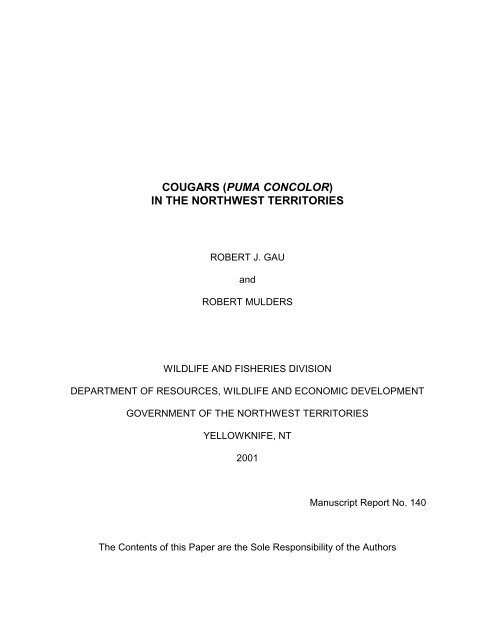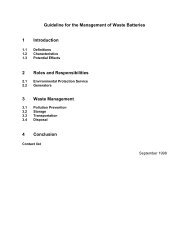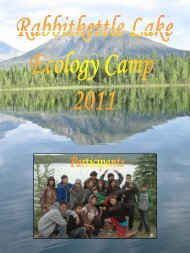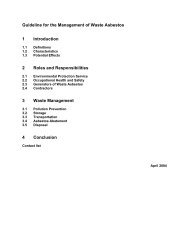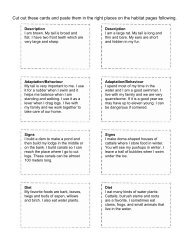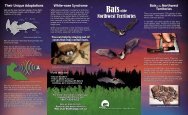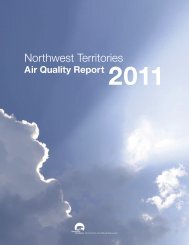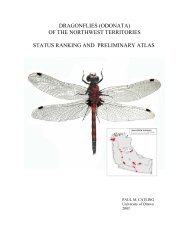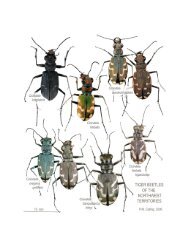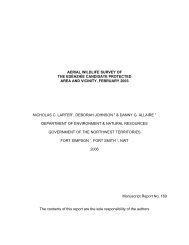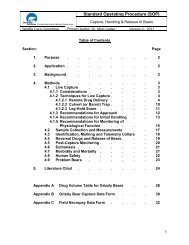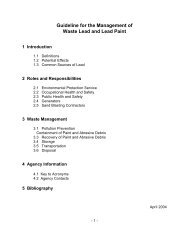140. Cougars (Puma Concolor) in the NWT - Environment and ...
140. Cougars (Puma Concolor) in the NWT - Environment and ...
140. Cougars (Puma Concolor) in the NWT - Environment and ...
You also want an ePaper? Increase the reach of your titles
YUMPU automatically turns print PDFs into web optimized ePapers that Google loves.
iiiTABLE OF CONTENTSABSTRACT ..................................................... iiLISTOFFIGURES ................................................vLISTOFTABLES ................................................ viINTRODUCTION ................................................. 1RESULTS ...................................................... 3DISCUSSION .................................................... 9RECOMMENDATIONS ........................................... 11ACKNOWLEDGMENTS ........................................... 13LITERATURECITED ............................................. 14APPENDIX A. Direct cougar occurrences <strong>in</strong> <strong>the</strong> Northwest Territories (n = 31).......................................................... 18APPENDIX B. Indirect cougar occurrences <strong>in</strong> <strong>the</strong> Northwest Territories (n = 12).......................................................... 30APPENDIX C. Direct <strong>and</strong> <strong>in</strong>direct cougar occurrences outside <strong>the</strong> NorthwestTerritories (n =15). ......................................... 35
ivLIST OF FIGURESFIGURE 1. Location of <strong>the</strong> direct cougar occurrences (n = 31) with <strong>the</strong> year ofsight<strong>in</strong>g (<strong>and</strong> RWED ID no.; See Appendix A) <strong>in</strong> <strong>the</strong> Northwest Territories........................................................... 5FIGURE 2. Location of <strong>the</strong> filtered direct cougar occurrences (n = 20) with <strong>the</strong>year of sight<strong>in</strong>g (<strong>and</strong> RWED ID no.; See Appendix A) <strong>in</strong> <strong>the</strong> NorthwestTerritories. ................................................. 6FIGURE 3. Location of <strong>the</strong> <strong>in</strong>direct cougar occurrences (n = 12) with <strong>the</strong> year ofsight<strong>in</strong>g (<strong>and</strong> RWED ID no.; See Appendix B) <strong>in</strong> <strong>the</strong> Northwest Territories........................................................... 7FIGURE 4. Location of cougar occurrences (n = 15) outside <strong>the</strong> NorthwestTerritories with <strong>the</strong> year of sight<strong>in</strong>g (<strong>and</strong> RWED ID no.; See Appendix C)........................................................... 8FIGURE 5. Suspected cougar tracks identified <strong>in</strong> RWED ID number 62, near <strong>the</strong>Fort Smith airport. Tracks measured 5 <strong>in</strong>ches across. Photos repr<strong>in</strong>tedwith permission (Mark Bradley, Parks Canada Wildlife Biologist).......................................................... 29
vLIST OF TABLESTABLE 1. Year <strong>and</strong> sight<strong>in</strong>g general location for <strong>the</strong> direct cougar occurrences <strong>in</strong><strong>the</strong>NorthwestTerritories....................................... 9
1INTRODUCTION<strong>Puma</strong> concolor has <strong>the</strong> widest distribution of any mammal <strong>in</strong> <strong>the</strong> westernhemisphere, except humans (Scott 1998). Its range extends from Chile, through<strong>the</strong> western United States, to <strong>the</strong> Yukon (L<strong>in</strong>dzey 1987; Beier 2000). Although thisfelid is known by many names throughout its range (mounta<strong>in</strong> lion, puma, pan<strong>the</strong>r,cougar), cougar is <strong>the</strong> common name most frequently used <strong>in</strong> nor<strong>the</strong>rn NorthAmerica. The most likely subspecies of cougar at <strong>the</strong> nor<strong>the</strong>rn extreme of <strong>the</strong>irrange is P. c. missoulensis, <strong>the</strong> same subspecies found <strong>in</strong> Alberta <strong>and</strong> nor<strong>the</strong>rnBritish Columbia (Klassen 2000).In Alberta <strong>and</strong> nor<strong>the</strong>rn British Columbia, cougars are primarily found <strong>in</strong>forested habitats similar to that used by its primary prey, white-tailed deer(Odocoileus virg<strong>in</strong>ianus) <strong>and</strong> mule deer (O. hemionus; Dixon 1982). It is oftendifficult for <strong>the</strong> people to observe cougars <strong>in</strong> <strong>the</strong> wild as <strong>the</strong> species generally hasa low population density <strong>and</strong> is cryptic <strong>and</strong> highly mobile (Ross et al. 1996). Forestcover may also obscure or reduce an observer’s view <strong>and</strong> lynx (Lynx canadensis),wolf (Canis lupis), coyote (C. latrans), feral or domestic animals may be mistakenfor cougars.Kuyt (1971) <strong>and</strong> Gau et al. (2001) noted that accounts of cougars <strong>in</strong> <strong>the</strong>Northwest Territories (<strong>NWT</strong>) are exceed<strong>in</strong>gly rare. Kuyt (1971) documented threeobservations of cougars from <strong>the</strong> Wood Buffalo National Park (WBNP) area from1962, 1967, <strong>and</strong> 1970. There were seven cougars harvested from <strong>the</strong> <strong>NWT</strong> <strong>in</strong>1919-1920 (Novak et al. 1987) however Obbard et al. (1987) noted those data,
2summarized from fur trad<strong>in</strong>g records, represent where <strong>the</strong> sk<strong>in</strong>s were sold <strong>and</strong>may not be <strong>the</strong> actual area of harvest. In o<strong>the</strong>r parts of Canada, <strong>the</strong>re has beenevidence of cougars outside <strong>the</strong>ir normal range <strong>in</strong> <strong>the</strong> Yukon Territory, Alberta,Saskatchewan, Manitoba, <strong>and</strong> Ontario northwest of Lake Superior (Nero <strong>and</strong>Wrigley 1977, Anderson 1983, Alberta Fish <strong>and</strong> Wildlife Division 1992, Klassen2000). Gau et al. (2001) recently documented <strong>the</strong> occurrence of cougars <strong>in</strong> <strong>and</strong>around <strong>the</strong> <strong>NWT</strong>. This report should be considered an update <strong>and</strong> expansion of<strong>the</strong>ir effort <strong>and</strong> <strong>in</strong>cludes details that were not permitted <strong>in</strong> a forum such as a peerreviewedjournal.METHODSAdd<strong>in</strong>g to <strong>the</strong> database constructed by Gau et al. (2001), cougar sight<strong>in</strong>gswere recorded from first h<strong>and</strong> visual accounts from Government of <strong>the</strong> <strong>NWT</strong>Department of Resources, Wildlife <strong>and</strong> Economic Development (RWED) Wildlifepersonnel, Parks Canada staff, <strong>and</strong> first h<strong>and</strong> sight<strong>in</strong>gs relayed directly to RWEDWildlife or Parks Canada staff. A sight<strong>in</strong>g was considered direct if <strong>the</strong> observerreport<strong>in</strong>g <strong>the</strong> event was <strong>the</strong> primary witness, <strong>the</strong> distance observed was less than250 metres, <strong>and</strong> identifiable characteristics (<strong>in</strong>clud<strong>in</strong>g colour, tail length, fur length,<strong>and</strong> body size) were described without prompt<strong>in</strong>g.Reports lack<strong>in</strong>g <strong>in</strong> descriptive detail <strong>and</strong> reports of only cougar tracks wereconsidered <strong>in</strong>direct <strong>and</strong> entered <strong>in</strong>to a separate database. Tracks of cougar <strong>and</strong>lynx can be hard to dist<strong>in</strong>guish based on size alone <strong>and</strong> <strong>the</strong> competency of <strong>the</strong>
observers can easily be called <strong>in</strong>to question.3RESULTSNote none of <strong>the</strong> cougar occurrences we report below nei<strong>the</strong>r <strong>in</strong>cluded cubsnor were wholly substantiated by <strong>the</strong> presentation of a carcass or photograph.Direct OccurrencesWe catalogued 31 direct visual sight<strong>in</strong>gs of cougars between <strong>the</strong> years1978 <strong>and</strong> 2001 <strong>in</strong> <strong>the</strong> <strong>NWT</strong> (Table 1; Fig. 1; Appendix A). However because largedistance movements have been reported for some cougars, we wanted to reduce<strong>the</strong> probability of report<strong>in</strong>g <strong>the</strong> same animal.Filtered Direct OccurrencesAnderson et al. (1992) reported maximum dispersal distances for 33 male<strong>and</strong> 32 female cougars from various North American populations to be 274 <strong>and</strong>140 kilometres respectively. Logan <strong>and</strong> Sweanor (2000) reported a 483 kilometredispersal for an <strong>in</strong>dividual cougar from his natal area to his mortality site, at 30months of age. Thus, we filtered our database to yield one sight<strong>in</strong>g per year froma 200 kilometre radius surround<strong>in</strong>g its coord<strong>in</strong>ates. Our filtered database has 20direct visual sight<strong>in</strong>gs of cougars <strong>in</strong> <strong>the</strong> <strong>NWT</strong> (Table 1; Fig. 2).Indirect OccurrencesEnsur<strong>in</strong>g quality control when evaluat<strong>in</strong>g reports of cougars from outsidesources is an <strong>in</strong>nate problem (Scott 1998). We <strong>in</strong>vestigated 12 occurrences of
4cougars where descriptive details were considered <strong>in</strong>direct but we recorded <strong>the</strong>mnone<strong>the</strong>less (Fig. 3; Appendix B). All occurrences of tracks were <strong>in</strong>cluded <strong>in</strong> <strong>the</strong>“<strong>in</strong>direct” category because of <strong>the</strong> similarities of cougar <strong>and</strong> lynx tracks. Also, wereceived numerous reports of trappers experienc<strong>in</strong>g problems with <strong>the</strong>ir trap-l<strong>in</strong>es(i.e. miss<strong>in</strong>g animals from traps) <strong>and</strong> suspected cougars as <strong>the</strong> culprits because oftracks. In those <strong>in</strong>stances however, specifics were generally not relayed <strong>and</strong> thusare not reported by us.Direct <strong>and</strong> Indirect Occurrences Outside <strong>the</strong> <strong>NWT</strong>Representatives from agencies with responsibilities outside our jurisdictionreported 15 cougar occurrences to us from outside <strong>the</strong> <strong>NWT</strong> border (Fig. 4;Appendix C).
FIGURE 1. Location of <strong>the</strong> direct cougar occurrences (n = 31) with <strong>the</strong> year ofsight<strong>in</strong>g (<strong>and</strong> RWED ID no.; See Appendix A) <strong>in</strong> <strong>the</strong> Northwest Territories.5
FIGURE 2. Location of <strong>the</strong> filtered direct cougar occurrences (n = 20) with <strong>the</strong>6year of sight<strong>in</strong>g (<strong>and</strong> RWED ID no.; See Appendix A) <strong>in</strong> <strong>the</strong> Northwest Territories.
FIGURE 3. Location of <strong>the</strong> <strong>in</strong>direct cougar occurrences (n = 12) with <strong>the</strong> year ofsight<strong>in</strong>g (<strong>and</strong> RWED ID no.; See Appendix B) <strong>in</strong> <strong>the</strong> Northwest Territories.7
FIGURE 4. Location of cougar occurrences (n = 15) outside <strong>the</strong> NorthwestTerritories with <strong>the</strong> year of sight<strong>in</strong>g (<strong>and</strong> RWED ID no.; See Appendix C).8
TABLE 1. Year <strong>and</strong> sight<strong>in</strong>g general location for <strong>the</strong> direct cougar occurrences <strong>in</strong><strong>the</strong> Northwest Territories.9Year General Location Year General Location1978 1 Virg<strong>in</strong>ia Falls, Nahanni National Park 1996 Near <strong>the</strong> community of Fort Smith1983 1 Hell Roar<strong>in</strong>g Creek, Nahanni National Park 1997 Near Chan Lake by Fort Providence1984 1 Near <strong>the</strong> community of Jean Marie River 1997 1 Near <strong>the</strong> community of Enterprise1987 1 Near <strong>the</strong> community of P<strong>in</strong>e Po<strong>in</strong>t 1997 1 Near <strong>the</strong> British Columbia-<strong>NWT</strong> border1987 Near <strong>the</strong> community of P<strong>in</strong>e Po<strong>in</strong>t 1998 Near <strong>the</strong> British Columbia-<strong>NWT</strong> border1990 1 Near <strong>the</strong> community of Fort Smith 1998 Near <strong>the</strong> community of Fort Liard1990 1 Hell Roar<strong>in</strong>g Creek, Nahanni National Park 1998 1 Near <strong>the</strong> community of Trout Lake1992 1 Alberta-<strong>NWT</strong> border 1999 1 Near <strong>the</strong> community of Fort Providence1992 1 Liard Trail-Mackenzie Highway junction 1999 Near <strong>the</strong> community of Hay River1994 1 Near <strong>the</strong> community of Edzo 1999 1 Near <strong>the</strong> community of Fort Smith1995 1 Near <strong>the</strong> community of Fort Smith 1999 Near <strong>the</strong> community of Fort Smith1996 1 60 km north of Fort Providence 2000 1 Southwest of Fort Providence1996 1,2 Near <strong>the</strong> community of Fort Smith 2000 1 Near <strong>the</strong> community of Fort Simpson1996 Near <strong>the</strong> community of Fort Smith 2000 Near <strong>the</strong> community of Fort Providence1996 Slave River near Wood Buffalo National Park 2001 1 Near <strong>the</strong> community of Fort Smith1996 Near <strong>the</strong> community of Fort Smith1 Year <strong>and</strong> location <strong>in</strong> filtered location database (Fig. 2).2 Two cougars were observed toge<strong>the</strong>r.DISCUSSIONIt appears cougars have exp<strong>and</strong>ed <strong>the</strong>ir North American range <strong>in</strong>to <strong>the</strong><strong>NWT</strong> (Gau et al. 2001; this report) <strong>and</strong> we believe a small, but viable, breed<strong>in</strong>gpopulation likely exists here. As a hunt<strong>in</strong>g season for General Licence Holders(GHL) on white-tailed deer <strong>and</strong> mule deer was established <strong>in</strong> 1998, <strong>and</strong> elk(Cervus elaphus) <strong>and</strong> are now known to regularly range <strong>in</strong>to <strong>the</strong> sou<strong>the</strong>rn <strong>NWT</strong>
10(G<strong>NWT</strong> unpublished data), <strong>the</strong>re appears to be an adequate cervid prey base tosusta<strong>in</strong> a <strong>NWT</strong> cougar population <strong>in</strong>to <strong>the</strong> future. Also, resident populations ofmoose (Alces alces), woodl<strong>and</strong> caribou (Rangifer tar<strong>and</strong>us), Dall’s sheep (Ovisdalli), mounta<strong>in</strong> goats (Oreamnos americanus), <strong>and</strong> snowshoe hare (Lepusamericanus) may contribute as dietary items for cougars <strong>in</strong> <strong>the</strong> <strong>NWT</strong> (Spald<strong>in</strong>g <strong>and</strong>Lesowski 1971; Ross <strong>and</strong> Jalkotzy 1996; Ross et al. 1997). Ultimately however, itrema<strong>in</strong>s unknown if <strong>the</strong> cougar occurrences we documented only representtransient <strong>in</strong>dividuals. Also, we acknowledge we cannot accurately determ<strong>in</strong>etrends <strong>in</strong> cougar abundance <strong>in</strong> <strong>the</strong> <strong>NWT</strong> from <strong>the</strong> reports we tabulated. Should itbecome more conclusive that a resident cougar population exists <strong>in</strong> <strong>the</strong> <strong>NWT</strong> (forexample: an <strong>in</strong>crease <strong>in</strong> <strong>the</strong> amount of cougars seen with cubs), we will need toconsider <strong>the</strong> potential affects cougars have on <strong>the</strong> behaviour, distribution,composition, <strong>and</strong> density of some ungulate species (Compton et al. 1995, Ross<strong>and</strong> Jalkotzy 1996; Wehausen 1996; Kunkel et al. 1999).The <strong>in</strong>direct cougar occurrences near Aklavik, one <strong>in</strong> 1993 <strong>and</strong> one <strong>in</strong> 1999,are noticeably removed from <strong>the</strong> o<strong>the</strong>r locations <strong>in</strong> our database. If accurate, <strong>the</strong>nwe assume <strong>the</strong> Aklavik reports to be ei<strong>the</strong>r transient <strong>in</strong>dividuals from <strong>the</strong> Yukon(Klassen 2000), or long range movements of transient <strong>in</strong>dividuals mov<strong>in</strong>g northus<strong>in</strong>g <strong>the</strong> Mackenzie River Valley as a travel corridor (Alberta Fish <strong>and</strong> WildlifeDivision 1992). If cougars are <strong>in</strong>deed <strong>in</strong> <strong>the</strong> Inuvialuit Settlement Region, <strong>the</strong>n <strong>the</strong>reports are truly remarkable as cougars are generally considered a short hairedfel<strong>in</strong>e (Beier 1999).
11Management implications for cougars <strong>in</strong> <strong>the</strong> <strong>NWT</strong> are currently limited.S<strong>in</strong>ce no cougar hunt<strong>in</strong>g season currently exists <strong>in</strong> <strong>the</strong> <strong>NWT</strong>, cougars cannot behunted legally by resident hunters. However, <strong>the</strong> Federal <strong>NWT</strong> Act guarantees allstatus Indians <strong>and</strong> Inuit <strong>the</strong> right to subsistence hunt any species not <strong>in</strong> danger ofext<strong>in</strong>ction on unoccupied Crown l<strong>and</strong>s. In that circumstance however, it is illegal tokeep or sell <strong>the</strong> hide for trophy purposes.RECOMMENDATIONS1. <strong>Cougars</strong> are frequently given a “high profile” by wildlife managers <strong>and</strong> <strong>the</strong>public because of <strong>the</strong>ir charismatic nature, <strong>in</strong>timidat<strong>in</strong>g size, <strong>and</strong> predatorybehaviour (British Columbia Resources Inventory Branch 1998). Howeverevents such as <strong>the</strong> cougar attack <strong>and</strong> result<strong>in</strong>g human death <strong>in</strong> Banff,Alberta, <strong>in</strong> January 2001 can perpetuate negative attitudes <strong>and</strong> hysteriaaga<strong>in</strong>st cougars <strong>in</strong> <strong>the</strong> public. Although North American cougar attacks onhumans have been <strong>in</strong>creas<strong>in</strong>g <strong>in</strong> recent years, fatalities are very rare (Beier1991). In <strong>the</strong> last 110 years, <strong>the</strong>re have been 96 documented cougarattacks <strong>and</strong> 18 of those have had human fatalities (Fitzhugh 2000).However s<strong>in</strong>ce 1991, <strong>the</strong>re have been 37 documented cougar attacks <strong>and</strong> 8of those have had human fatalities (Fitzhugh 2000 updated with January2001 data). Thus, a safety <strong>and</strong> general <strong>in</strong>formation packet (i.e. a published“Wildlife Sketch”) <strong>and</strong>/or species description l<strong>in</strong>k on:http://www.nwtwildlife.rwed.gov.nt.ca/<strong>NWT</strong>wildlife/nwtwildlife.htm should be
12made available to <strong>the</strong> public. This <strong>in</strong>formation would aim to <strong>in</strong>form, providesafety <strong>in</strong>formation, <strong>and</strong> reduce potential public apprehension towardscougars.2. Collect<strong>in</strong>g sight<strong>in</strong>g reports should be cont<strong>in</strong>ued. The Wildlife <strong>and</strong> FisheriesDivision should act as <strong>the</strong> liaison between Parks Canada (Parks CanadaWardens) <strong>and</strong> Regional RWED offices (G<strong>NWT</strong> Biological field staff <strong>and</strong>Wildlife Officers) to biannually tabulate future cougar occurrences.3. With <strong>the</strong> high <strong>in</strong>cidence of cougars <strong>in</strong> Wood Buffalo National Park (Gau etal. 2001), aerial or ground based surveys conducted <strong>in</strong> <strong>the</strong> North Slave <strong>and</strong>South Slave Regions (i.e. moose, bison or beaver lodge surveys) shouldalso <strong>in</strong>corporate a search for, <strong>and</strong> document (photographs, measurements,etc...), cougar tracks <strong>in</strong> bare dirt or snow. Cougar track counts arecommonly made along roads from a mov<strong>in</strong>g vehicle or, <strong>in</strong> snow, alongtransects from helicopters particularly <strong>in</strong> areas with open forest cover [seereviews by Scott (1998) <strong>and</strong> British Columbia Resources Inventory Branch(1998) for fur<strong>the</strong>r <strong>in</strong>formation].4. The current Government of <strong>the</strong> <strong>NWT</strong> “Species at Risk” programme statescougars are of “Undeterm<strong>in</strong>ed” status, at <strong>the</strong> limit or edge of <strong>the</strong>ir range <strong>in</strong><strong>the</strong> <strong>NWT</strong>, <strong>and</strong> have a small distribution (less than 10% of <strong>NWT</strong>) <strong>and</strong> hencesmall population is expected (Government of <strong>the</strong> Northwest Territories2000). If cougars’ range <strong>in</strong> <strong>the</strong> <strong>NWT</strong> <strong>in</strong>cludes <strong>the</strong> Inuvialuit, <strong>the</strong>n regulatoryagencies should acknowledge cougars may range <strong>in</strong> > 10% of <strong>the</strong> <strong>NWT</strong>’s
13l<strong>and</strong>mass <strong>and</strong> thus <strong>the</strong> cougar population <strong>in</strong> <strong>the</strong> <strong>NWT</strong> may be larger thanfirst estimated.5. Should it become conclusive that a resident population of cougars exists <strong>in</strong><strong>the</strong> <strong>NWT</strong>, local hunter <strong>and</strong> trapper oganizations should be advised of <strong>the</strong>potential affects cougars have on <strong>the</strong> behaviour, distribution, composition,<strong>and</strong> density of some ungulate species (Compton et al. 1995, Ross <strong>and</strong>Jalkotzy 1996; Wehausen 1996; Kunkel et al. 1999).6. When <strong>the</strong> first cougar <strong>in</strong> <strong>the</strong> <strong>NWT</strong> is eventually harvested, or carcass (roadkilledor o<strong>the</strong>rwise) is found, a detailed necropsy should be promptlyconducted ensur<strong>in</strong>g <strong>the</strong> follow<strong>in</strong>g are collected: <strong>the</strong> skull, stomach contents,ovaries <strong>and</strong> uterus (if female), <strong>and</strong> muscle <strong>and</strong> hair samples for DNAanalysis. The necropsy protocol should also <strong>in</strong>clude measurements of:not<strong>in</strong>g of <strong>the</strong> overall animal health <strong>and</strong> condition of <strong>in</strong>ternal organs,condition of <strong>the</strong> teeth, approximate age, high <strong>and</strong> low neck circumference,body length, tail length, chest girth, front <strong>and</strong> h<strong>in</strong>d pad widths <strong>and</strong> lengths,head circumference, skull length, zygomatic breadth, upper <strong>and</strong> lowercan<strong>in</strong>e widths at <strong>the</strong> tips, upper <strong>and</strong> lower can<strong>in</strong>e widths at <strong>the</strong> base, nippledistension (if female), <strong>and</strong> body weight.ACKNOWLEDGMENTSThe authors thank L. Gunn, T. Lamb, P.I. Ross, K. Poole, E. Krutko, S.Ransom, J. Hordal, I. McLeod, K. Davidge, D. Williams, A. Helmer, R. Bourget,
14H.D. Cluff, S. Douglas, B. Bergman, C. Lafferty, M. Rosen <strong>and</strong> <strong>the</strong> o<strong>the</strong>r observers<strong>and</strong> trappers that took <strong>the</strong> time to report <strong>the</strong>ir f<strong>in</strong>d<strong>in</strong>gs directly to <strong>the</strong> <strong>in</strong>terestedWardens, Biologists, <strong>and</strong> Wildlife Officers.LITERATURE CITEDAlberta Fish <strong>and</strong> Wildlife Division. 1992. Management plan for cougars <strong>in</strong> Alberta.Wildlife Management Plann<strong>in</strong>g Series Number 5. Edmonton, Alberta. 91pages.Anderson, A.E. 1983. A critical review of literature on puma (Felis concolor).Special Report Number 54. Colorado Division of Wildlife. Fort Coll<strong>in</strong>s,Colorado. 91 pages.Anderson, A. E., D. C. Bowden, <strong>and</strong> D. M. Kattner. 1992. The puma onUncompahgre Plateau, Colorado. Technical Publication Number 40.Colorado Division of Wildlife. Fort Coll<strong>in</strong>s, Colorado. 116 pages.Beier, P. 1999. Cougar <strong>in</strong> The Smithsonian Book of North American Mammals.D. E. Wilson <strong>and</strong> S. Ruff editors. UBC Press: Vancouver, British Columbia.Pages 226-228.Beier, P. 1991. Cougar attacks on humans <strong>in</strong> <strong>the</strong> United States <strong>and</strong> Canada.Wildlife Society Bullet<strong>in</strong> 19:403-412.British Columbia Resources Inventory Branch. 1998. Inventory methods for wolf<strong>and</strong> cougar: st<strong>and</strong>ards for components of British Columbia’s biodiviersity no.34. Prepared by <strong>the</strong> M<strong>in</strong>istry of <strong>Environment</strong>, L<strong>and</strong>s <strong>and</strong> Parks - Resources
15Inventory Branch for <strong>the</strong> Terrestrial Ecosystems Task Force - ResourcesInventory Committee. 56 pages.Compton, B. B., P. Zager, <strong>and</strong> G. Servheen. 1995. Survival <strong>and</strong> mortality oftranslocated woodl<strong>and</strong> caribou. Wildlife Society Bullet<strong>in</strong> 23:490-496.Dixon, K. R. 1982. Mounta<strong>in</strong> lion <strong>in</strong> Wild Mammals of North America: biology,management, economics. J. A. Chapman <strong>and</strong> G. A. Feldhamer editors.Johns Hopk<strong>in</strong>s University Press: Baltimore, Maryl<strong>and</strong>. Pages 711-727.Fitzhugh, E. L. 2000. Chang<strong>in</strong>g dynamics of puma attacks on humans.Unpublished data. Sixth Mounta<strong>in</strong> Lion Workshop, December 12-14, 2000,San Antonio, Texas, USA.Gau, R. J., R. Mulders, T. Lamb, <strong>and</strong> L. Gunn. 2001. <strong>Cougars</strong> (<strong>Puma</strong> concolor) <strong>in</strong><strong>the</strong> Northwest Territories <strong>and</strong> Wood Buffalo National Park. Arctic 54(2).Government of <strong>the</strong> Northwest Territories. 2000. <strong>NWT</strong> species 2000: generalstatus ranks of wild species <strong>in</strong> <strong>the</strong> Northwest Territories. Government of <strong>the</strong>Northwest Territories Department of Resources, Wildlife <strong>and</strong> EconomicDevelopment: Yellowknife, NT. 50 pages.Klassen, D. 2000. <strong>Cougars</strong> <strong>in</strong> <strong>the</strong> Yukon. Yukon Department of RenewableResources Technical Report. Whitehorse, Yukon. 47 pages.Kunkel, K. E., T. K. Ruth, D. H. Pletscher, <strong>and</strong> M. G. Hornocker. 1999. W<strong>in</strong>terprey selection by wolves <strong>and</strong> cougars <strong>in</strong> <strong>and</strong> near Glacier National Park,Montana. Journal of Wildlife Management 63:901-910.Kuyt, E. 1971. Possible occurrence of cougar near Fort Smith, N.W.T. Blue Jay
1629:142-143.L<strong>in</strong>dzey, F. 1987. Mounta<strong>in</strong> lion <strong>in</strong> Wild Furbearer Management <strong>and</strong> Conservation<strong>in</strong> North America. M. Novak, J. A. Baker, M. E. Obbard, <strong>and</strong> B. Mallocheditors. Ontario M<strong>in</strong>istry of Natural Resources: Toronto, Ontario. Pages657-668.Logan, K. A. <strong>and</strong> L. L. Sweanor. 2000. <strong>Puma</strong> <strong>in</strong> Ecology <strong>and</strong> management oflarge mammals <strong>in</strong> North America. S. Demarais <strong>and</strong> P. Krausman editors.Prentice Hall: Englewood Cliffs, New Jersey. Pages 347-377.Nero, R. W. <strong>and</strong> R. E. Wrigley. 1977. Status <strong>and</strong> habits of <strong>the</strong> cougar <strong>in</strong>Manitoba. Canadian-Field Naturalist 91:28-40.Novak, M., M. E. Obbard, J. G. Jones, R. Newman, A. Booth, A. J. Satterthwaite,<strong>and</strong> G. L<strong>in</strong>scombe. 1987. Furbearer harvests <strong>in</strong> North America, 1600 -1984. Ontario M<strong>in</strong>istry of Natural Resources: Toronto, Ontario. 271 pages.Obbard, M. E., J. G. Jones, R. Newman, A. Booth, A. J. Satterthwaite, <strong>and</strong> G.L<strong>in</strong>scombe. 1987. Furbearer harvests <strong>in</strong> North America <strong>in</strong> Wild FurbearerManagement <strong>and</strong> Conservation <strong>in</strong> North America. M. Novak, J. A. Baker,M. E. Obbard, <strong>and</strong> B. Malloch editors. Ontario M<strong>in</strong>istry of NaturalResources: Toronto, Ontario. Pages 1007-1034.Ross, P. I. <strong>and</strong> M. G. Jalkotzy. 1992. Characteristics of a hunted population ofcougars <strong>in</strong> southwestern Alberta. Journal of Wildlife Management 56:417-426.Ross, P. I., <strong>and</strong> M. G. Jalkotzy. 1996. Cougar predation on moose <strong>in</strong>
17southwestern Alberta. Alces 32:1-8.Ross, P. I., M. G. Jalkotzy, <strong>and</strong> J. R. Gunson. 1996. The quota system of cougarharvest management <strong>in</strong> Alberta. Wildlife Society Bullet<strong>in</strong> 24:490-494.Ross, P. I., M. G. Jalkotzy, <strong>and</strong> M. Festa-Bianchet. 1997. Cougar predation onbighorn sheep <strong>in</strong> southwestern Alberta dur<strong>in</strong>g w<strong>in</strong>ter. Canadian Journal ofZoology 74:771-775.Scott, F. 1998. Update COSEWIC status report on cougar, eastern population,<strong>Puma</strong> concolor couguar. Committee on <strong>the</strong> Status of Endangered Wildlife<strong>in</strong> Canada: Ottawa, Ontario. 33 pages.Spald<strong>in</strong>g, D. J. <strong>and</strong> J. Lesowski. 1971. W<strong>in</strong>ter food of <strong>the</strong> cougar <strong>in</strong> south-centralBritish Columbia. Journal of Wildlife Management 35:378-381.Wehausen, J. D. 1996. Effects of mounta<strong>in</strong> lion predation on bighorn sheep <strong>in</strong><strong>the</strong> Sierra Nevada <strong>and</strong> Granite Mounta<strong>in</strong>s of California. Wildlife SocietyBullet<strong>in</strong> 24:471-479.
APPENDIX A. Direct cougar occurrences <strong>in</strong> <strong>the</strong> Northwest Territories (n = 31).18Year: 1978 1 .Month/Season:April.Reported to:Robert Gau, Wildlife <strong>and</strong> Fisheries, RWED.Type:Visual.Coord<strong>in</strong>ates:61 o 36' N latitude, 125 o 44' W longitude.Location:Virg<strong>in</strong>ia Falls, Nahanni National Park.Additional comments:RWED ID no.: 60.__________________Seen while fly<strong>in</strong>g on <strong>the</strong> edge of <strong>the</strong> river above Virg<strong>in</strong>iaFalls st<strong>and</strong><strong>in</strong>g approximately 10-15 yards off on <strong>the</strong> ice<strong>in</strong> early April.Year: 1983 1 .Month/Season:August.Reported to:Bill Thorpe, Warden, Nahanni National Park.Type:Visual.Coord<strong>in</strong>ates:61 o 53' N latitude, 126 o 30' W longitude.Location:Near <strong>the</strong> Hell Roar<strong>in</strong>g <strong>and</strong> Flood Creeks, on <strong>the</strong> bank of<strong>the</strong> South Nahanni River, Nahanni National Park.Additional comments: Reported by a group of Belgian canoeists. The leaderdescribed it as a puma <strong>and</strong> noted a reddish-brownpelage <strong>and</strong> a long tail. Although from Europe, <strong>the</strong>leader has travelled extensively <strong>in</strong> western NorthAmerica aware of <strong>the</strong> different fel<strong>in</strong>e species. At least 2different <strong>in</strong>dividuals observed <strong>the</strong> animal.RWED ID no.: 48.__________________1 Denotes a mapped filtered occurrence (Table 1; Fig. 2).
Year: 1984 1 .Month/Season:W<strong>in</strong>ter.Reported to:Robert Gau, Wildlife <strong>and</strong> Fisheries, RWED.Type:Visual.Coord<strong>in</strong>ates:61 o 31' N latitude, 120 o 38' W longitude.Location:Jean Marie River.Additional comments: Seen just outside <strong>the</strong> community. Tan coat <strong>and</strong> longtail were clearly visible as it crossed <strong>the</strong> road.RWED ID no.: 6.__________________19Year: 1987 1 .Month/Season:Summer.Reported to:Al Helmer, Renewable Resources Officer.Type:Visual.Coord<strong>in</strong>ates:60 o 59' N latitude, 114 o 01' W longitude.Location:Near Paulette Bay.Additional comments:RWED ID no.: 7.__________________The mail truck driver between P<strong>in</strong>e Po<strong>in</strong>t <strong>and</strong> FortResolution claimed to have seen a cougar twice on <strong>the</strong>highway. The long tail was what conv<strong>in</strong>ced her it was acougar. She had trapped lynx with her fa<strong>the</strong>r <strong>and</strong>appeared to know <strong>the</strong> difference between <strong>the</strong> twoanimals.Year: 1987.Month/Season:Summer.Reported to:Al Helmer, Renewable Resources Officer.Type:Visual.Coord<strong>in</strong>ates:60 o 50' N latitude, 114 o 28' W longitude.Location:P<strong>in</strong>e Po<strong>in</strong>t.Additional comments:RWED ID no.: 8.__________________Three Com<strong>in</strong>co employees, all from British Columbia<strong>and</strong> ei<strong>the</strong>r cougar hunters or cougar hunters withhounds, while hav<strong>in</strong>g lunch near P<strong>in</strong>e Po<strong>in</strong>t watched acougar walk out onto a small gravel pile ~100 yardsaway from <strong>the</strong>m. They <strong>the</strong>n walked to with<strong>in</strong> 100 ft of<strong>the</strong> animal before it got up, stretched, <strong>the</strong>n loped <strong>in</strong>to<strong>the</strong> bush. They said it was a female <strong>and</strong> <strong>in</strong> appeared <strong>in</strong>good condition.
20Year: 1990 1 .Month/Season:Summer.Reported to:Sholto Douglas, Renewable Resources Officer.Type:Visual.Coord<strong>in</strong>ates:60 o 16' N latitude, 114 o 00' W longitude.Location:Highway 5, ~70mi west of Fort Smith.Additional comments: Bucksk<strong>in</strong> coloured cougar with a long tail sitt<strong>in</strong>g alongside <strong>the</strong> road.RWED ID no.: 9.__________________Year: 1990 1 .Month/Season:July.Reported to:Carl Lafferty, Senior Park Warden, Nahanni NationalPark.Type:Visual.Coord<strong>in</strong>ates:61 o 45' N latitude, 126 o 45' W longitude.Location:Hell Roar<strong>in</strong>g Creek, Nahanni National Park.Additional comments: A large cat with a dist<strong>in</strong>guish<strong>in</strong>g long tail was observedcross<strong>in</strong>g a small creek, along <strong>the</strong> South Nahanni River.RWED ID no.: 42.__________________Year: 1992 1 .Month/Season:December.Reported to:Jerry Hordal, Renewable Resources Officer.Type:Visual.Coord<strong>in</strong>ates:60 o 00' N latitude, 115 o 47' W longitude.Location:<strong>NWT</strong> border.Additional comments: Seen while out on <strong>the</strong> l<strong>and</strong>. Tan <strong>in</strong> colour with a longtail. Observation made by a very experienced trapper.RWED ID no.: 13.__________________
21Year: 1992 1 .Month/Season:W<strong>in</strong>ter.Reported to:Dave Williams, Manager, Enforcement RWED.Type:Visual.Coord<strong>in</strong>ates:61 o 27' N latitude, 121 o 15' W longitude.Location:Liard - Mackenzie Highway junction.Additional comments: Reliable sight<strong>in</strong>g by local harvesters as <strong>the</strong> animalcrossed <strong>the</strong> highway. Tracks were later <strong>in</strong>vestigated by<strong>the</strong> Renewable Resources Officer <strong>and</strong> he also agrees itwas a cougar.RWED ID no.: 14.__________________Year: 1994 1 .Month/Season:January.Reported to:Kim Poole, Wildlife <strong>and</strong> Fisheries, RWED.Type:Visual.Coord<strong>in</strong>ates:62 o 49' N latitude, 116 o 04' W longitude.Location:Stagg River.Additional comments:RWED ID no.: 16.__________________Seen ~2mi east of Stagg River near Rae-Edzo from~200m. Believed it was a cougar he saw as a long tailwas seen <strong>and</strong> it was def<strong>in</strong>itly not a fox or o<strong>the</strong>r animal.Year: 1995 1 .Month/Season:Summer.Reported to:Sam Ransom, Manager Fort Smith RWED.Type:Visual.Coord<strong>in</strong>ates:60 o 00' N latitude, 111 o 53' W longitude.Location:Fort Smith.Additional comments: Seen <strong>in</strong> town on McDougald Road <strong>in</strong> <strong>the</strong> morn<strong>in</strong>g.Complete description of <strong>the</strong> animal was given.RWED ID no.: 61.__________________
22Year: 1996.Month/Season:Summer.Reported to:Sholto Douglas, Renewable Resources Officer.Type:Visual.Coord<strong>in</strong>ates:60 o 02' N latitude, 111 o 47' W longitude.Location:Fort Smith slide zone.Additional comments: A cougar had been repeated seen along <strong>the</strong> river slidezone <strong>and</strong> <strong>the</strong> Renewable Resources office had multiplereports from this area.RWED ID no.: 20.__________________Year: 1996 1 .Month/Season:W<strong>in</strong>ter.Reported to:Robert Mulders, Wildlife <strong>and</strong> Fisheries, RWED.Type:Visual.Coord<strong>in</strong>ates:60 o 02' N latitude, 113 o 15' W longitude.Location:Wood Buffalo National Park.Additional comments: Two cougars were observed toge<strong>the</strong>r cross<strong>in</strong>g <strong>the</strong> roadright <strong>in</strong> front of <strong>the</strong> observer.RWED ID no.: 21.__________________Year: 1996 1 .Month/Season:June.Reported to:Kim Poole, Wildlife <strong>and</strong> Fisheries, RWED.Type:Visual.Coord<strong>in</strong>ates:61 o 50' N latitude, 117 o 40' W longitude.Location:~60km north of Fort Providence.Additional comments:RWED ID no.: 22.__________________A large cat seen with a long tail. Seen ~250m away but<strong>in</strong> good light. One o<strong>the</strong>r observer with him also agreedit was a cougar.
23Year: 1996.Month/Season:August.Reported to:Robert Gau, Wildlife <strong>and</strong> Fisheries, RWED.Type:Visual.Coord<strong>in</strong>ates:60 o 00' N latitude, 112 o 30' W longitude.Location:Parson’s Lake road, Wood Buffalo National Park.Additional comments: Just turn<strong>in</strong>g onto Parson’s Lake road he saw a large tancoloured cat with a long tail walk across <strong>the</strong> road from~500 feet away.RWED ID no.: 40.__________________Year: 1996Month/Season:FallReported to:Tamara Lamb, Park Warden, Wood Buffalo NationalPark.Type:Visual.Coord<strong>in</strong>ates:60 o 00' N latitude, 112 o 24' W longitude.Location:Near Salt Mounta<strong>in</strong>.Additional comments: Observation made while chicken hunt<strong>in</strong>g <strong>and</strong> turn<strong>in</strong>gonto Highway 5 towards Fort Smith. He <strong>the</strong>n saw alarge animal run from <strong>the</strong> ditch <strong>in</strong>to <strong>the</strong> trees. He didnot see its head but it had catlike features, a short haircoat <strong>and</strong> a 2-3 ft long tail. He says that <strong>the</strong>re is no wayit could have been a lynx or a species from <strong>the</strong> can<strong>in</strong>efamily.RWED ID no.: 41.__________________Year: 1996.Month/Season:September.Reported to:Tamara Lamb, Park Warden, Wood Buffalo NationalPark.Type:Visual.Coord<strong>in</strong>ates:60 o 23' N latitude, 112 o 27' W longitude.Location:West of Gr<strong>and</strong> Detour on <strong>the</strong> Slave River.Additional comments: Animal seen from a helicopter ly<strong>in</strong>g down beside <strong>the</strong>river bank.RWED ID no.: 45.__________________
Year: 1997 1 .Month/Season:Fall.Reported to:Jerry Hordal, Renewable Resources Officer.Type:Visual.Coord<strong>in</strong>ates:60 o 25' N latitude, 116 o 15' W longitude.Location:~15km south of Enterprise.Additional comments: Tan colouration <strong>and</strong> a long tail reported to be seen.RWED ID no.: 23.__________________24Year: 1997 1 .Month/Season:March.Reported to:Michel Lab<strong>in</strong>e, Renewable Resources Officer.Type:Visual.Coord<strong>in</strong>ates:60 o 00' N latitude, 122 o 56' W longitude.Location: Highway #7, km 0.Additional comments: Seen by a truck driver at <strong>the</strong> <strong>NWT</strong>-BC border whilestopped at a road side pull-out.RWED ID no.: 65.__________________Year: 1997.Month/Season:Fall.Reported to:Evelyn Krutko, Renewable Resources Officer.Type:Visual.Coord<strong>in</strong>ates:61 o 40' N latitude, 116 o 58' W longitude.Location: Chan Lake, Highway 3.Additional comments: Observed a cougar cross<strong>in</strong>g <strong>the</strong> road.RWED ID no.: 24.__________________
Year: 1998 1 .Month/Season:W<strong>in</strong>ter.Reported to:Al Helmer, Renewable Resources Officer.Type:Visual.Coord<strong>in</strong>ates:60 o 33' N latitude, 120 o 00' W longitude.Location:Dogface Lake.Additional comments:RWED ID no.: 26.__________________25While out trapp<strong>in</strong>g just east of Redknife Hills by TroutLake he noticed fresh, extremely large, lynx tracks on<strong>the</strong> trail <strong>in</strong> front of him. As he got to a small lake hewatched <strong>the</strong> animal lop<strong>in</strong>g across <strong>the</strong> lake. He caughtup to it <strong>and</strong> travelled almost beside it <strong>and</strong> stated withouta doubt it was a cougar. He observed <strong>the</strong> tracksseveral more times dur<strong>in</strong>g <strong>the</strong> next three weeks that hewas <strong>the</strong>re.Year: 1998.Month/Season:March.Reported to:Michel Lab<strong>in</strong>e, Renewable Resources Officer.Type:Visual.Coord<strong>in</strong>ates:60 o 13' N latitude, 123 o 23' W longitude.Location: Highway #7, km 35.Additional comments: Just south of Fort Liard. Numerous truckers reported ask<strong>in</strong>ny, bold cougar to be feed<strong>in</strong>g on <strong>the</strong>ir unf<strong>in</strong>ishedlunches.RWED ID no.: 66.__________________Year: 1998.Month/Season:June.Reported to:Robert Gau, Wildlife <strong>and</strong> Fisheries, RWED.Type:Visual.Coord<strong>in</strong>ates:60 o 04' N latitude, 122 o 58' W longitude.Location: Highway #7, km 4.Additional comments: Cougar seen cross<strong>in</strong>g <strong>the</strong> road by a <strong>NWT</strong> RenewableResources Officer.RWED ID no.: 64.__________________
26Year: 1999.Month/Season:December.Reported to:Jerry Hordal, Renewable Resources Officer.Type:Visual.Coord<strong>in</strong>ates:60 o 45' N latitude, 115 o 47' W longitude.Location:~5km out along <strong>the</strong> Hay River rail-l<strong>in</strong>e.Additional comments: Tan <strong>in</strong> colour with a long tail. Observation made by avery experienced trapper.RWED ID no.: 28.__________________Year: 1999 1 .Month/Season:September.Reported to:Evelyn Krutko, Renewable Resources Officer.Type:Visual.Coord<strong>in</strong>ates:61 o 30' N latitude, 118 o 01' W longitude.Location:Horn River Road.Additional comments: While four-wheel<strong>in</strong>g ~10km up <strong>the</strong> Horn River Road<strong>the</strong>y saw what looked exactly like a cougar <strong>and</strong> it had along tail. When he <strong>and</strong> his wife went by <strong>the</strong> area <strong>and</strong>turned around, it was still on <strong>the</strong> road.RWED ID no.: 29.__________________Year: 1999 1 .Month/Season:September.Reported to:Libby Gunn, Park Warden, Wood Buffalo National Park.Type:Visual.Coord<strong>in</strong>ates:60 o 00' N latitude, 112 o 35' W longitude.Location:Little Buffalo River.Additional comments: He saw a cougar cross Highway 5 about a half hourbefore dark. He clearly saw a long tail <strong>and</strong> estimated<strong>the</strong> cat was very large (almost to waist height).Observation made by someone from British Columbia<strong>and</strong> had seen cougars before.RWED ID no.: 32.__________________
Year: 1999.Month/Season:Summer.Reported to:Mike Rosen, Instructor Aurora College.Type:Visual.Coord<strong>in</strong>ates:60 o 02' N latitude, 113 o 00' W longitude.Location: Highway 5.Additional comments:RWED ID no.: 36.__________________27Crossed Highway 5 ~80 km west of Fort Smith.Ano<strong>the</strong>r observer also spotted a cougar near <strong>the</strong> samelocation on <strong>the</strong> same day. There were cow buffalo <strong>and</strong>calves nearby.Year: 2000.Month/Season:May.Reported to:Robert Gau, Wildlife <strong>and</strong> Fisheries, RWED.Type:Visual.Coord<strong>in</strong>ates:61 o 21' N latitude, 117 o 38' W longitude.Location:Fort Providence airport.Additional comments:RWED ID no.: 50.__________________Observation made by very experienced trappers. Theyobserved a tan coloured cougar with a long tail cross<strong>the</strong> road very close to <strong>the</strong> local airport.Year: 2000 1 .Month/Season:May.Reported to:Robert Gau, Wildlife <strong>and</strong> Fisheries, RWED.Type:Visual.Coord<strong>in</strong>ates:61 o 53' N latitude, 126 o 30' W longitude.Location:Sou<strong>the</strong>rn shore of <strong>the</strong> Mackenzie River from FortProvidence.Additional comments: Observation made by very experienced trappers. Theyobserved a tan coloured cougar with a long tail cross<strong>in</strong>g<strong>the</strong> highway.RWED ID no.: 51.__________________
28Year: 2000 1 .Month/Season:August.Reported to:Douglas Tate, Conservation Biologist, Nahanni NationalPark.Type:Visual.Coord<strong>in</strong>ates:61 o 37' N latitude, 121 o 27' W longitude.Location:~25-30km south-sou<strong>the</strong>ast of Ft Simpson.Additional comments: Approximately half way from <strong>the</strong> ferry to Checkpo<strong>in</strong>t on<strong>the</strong> side of <strong>the</strong> road. The sight<strong>in</strong>g was brief but clear100m. It was much longer <strong>and</strong> bigger than a lynx with apronounced long tail. The cougar crossed <strong>the</strong> road <strong>and</strong>headed on <strong>in</strong>to <strong>the</strong> bush.RWED ID no.: 55.__________________Year: 2001 1 .Month/Season:March.Reported to:Libby Gunn, Park Warden, Wood Buffalo National Park.Type:Visual.Coord<strong>in</strong>ates:60 o 00' N latitude, 111 o 53' W longitude.Location:Near <strong>the</strong> airport at Fort Smith.Additional comments: The observers saw someth<strong>in</strong>g black-look<strong>in</strong>g leap out of<strong>the</strong> ditch on <strong>the</strong> north side of <strong>the</strong> road <strong>and</strong> cross it. Onedescribed "an amaz<strong>in</strong>g leap". Her first thought was thatit was a cougar, s<strong>in</strong>ce it was not like any cat she hadever seen, <strong>and</strong> it had a very long tail. She fur<strong>the</strong>rdescribed <strong>the</strong> animal as be<strong>in</strong>g dark, <strong>and</strong> verystreaml<strong>in</strong>ed, "not fluffy like a lynx." She estimates <strong>the</strong>animal was about 100 to 150 metres away, <strong>and</strong> sheonly saw it for 4 or 5 seconds. Site later <strong>in</strong>vestigated byParks Canada staff <strong>and</strong> photos recorded (Fig. 5).RWED ID no.: 62.__________________
29FIGURE 5. Suspected cougar tracks identified <strong>in</strong> RWED ID number 62, near <strong>the</strong>Fort Smith airport. Tracks measured 5 <strong>in</strong>ches across. Photos repr<strong>in</strong>ted withpermission (Mark Bradley, Parks Canada Wildlife Biologist).
30APPENDIX B. Indirect cougar occurrences <strong>in</strong> <strong>the</strong> Northwest Territories (n = 12).Year: 1982.Month/Season:July.Reported to:Tom Hurd, Warden, Parks Canada.Type:Visual.Coord<strong>in</strong>ates:61 o 20' N latitude, 124 o 55' W longitude.Location:South Nahanni River on <strong>the</strong> Prairie Creek flood pla<strong>in</strong>(near mouth).Additional comments: While camped at <strong>the</strong> Forestry cab<strong>in</strong> campsite <strong>in</strong>Deadmen Valley, 3 or 4 people claim <strong>the</strong>y saw a largecat with a long tail. Observation distance was ~150m.A search for tracks yielded noth<strong>in</strong>g.RWED ID no.: 46.__________________Year: 1983.Month/Season:July.Reported to:Dave Milne <strong>and</strong> Bill Thorpe, Wardens, Parks Canada.Type:Visual.Coord<strong>in</strong>ates:61 o 52' N latitude, 126 o 35' W longitude.Location:Between Moose Ponds <strong>and</strong> Nahanni Butte.Additional comments: A large cat was seen pursu<strong>in</strong>g a cow moose on <strong>the</strong>South Nahanni River (streambank), near Azure Creek,~50 miles upstream from <strong>the</strong> confluence with <strong>the</strong>Broken Skull River. The tourist group leader describedit as a cougar to but when asked about <strong>the</strong> tail, he didn'trecall see<strong>in</strong>g it. At least two o<strong>the</strong>r people from <strong>the</strong>group claim <strong>the</strong>y saw it.RWED ID no.: 47.__________________
31Year: 1990.Month/Season:W<strong>in</strong>ter.Reported to:Jerry Hordal, Renewable Resources Officer.Type:Tracks.Coord<strong>in</strong>ates:60 o 06' N latitude, 117 o 53' W longitude.Location:Cameron Hills.Additional comments: He said <strong>the</strong> tracks of a cougar crossed his trap-l<strong>in</strong>e <strong>and</strong>he could see tail drag marks <strong>in</strong> <strong>the</strong> snow between <strong>the</strong>tracks.RWED ID no.: 11.__________________Year: 1992.Month/Season:W<strong>in</strong>ter.Reported to:Robert Gau, Wildlife <strong>and</strong> Fisheries, RWED.Type:Tracks.Coord<strong>in</strong>ates:61 o 52' N latitude, 117 o 45' W longitude.Location:North of Fort Providence.Additional comments:RWED ID no.: 58.__________________Followed tracks that looked like very large lynx tracksexcept for <strong>the</strong> unusual fact that <strong>the</strong>y sunk down too far<strong>in</strong>to <strong>the</strong> snow. The tracks had been follow<strong>in</strong>g woodl<strong>and</strong>caribou.Year: 1993.Month/Season:November.Reported to:Ian McLeod, Renewable Resources Officer.Type:Tracks.Coord<strong>in</strong>ates:68 o 07' N latitude, 135 o 00' W longitude.Location:Aklavik.Additional comments: After an experienced trapper lodged several compla<strong>in</strong>tsabout someth<strong>in</strong>g bo<strong>the</strong>r<strong>in</strong>g his traps, <strong>and</strong> hav<strong>in</strong>g anumber of lynx removed from his trap-l<strong>in</strong>e, he spottedlarge cougar tracks. Pictures were reported taken of<strong>the</strong> tracks <strong>and</strong> supposed tail drag-marks can also beseen.RWED ID no.: 15.__________________
Year: 1999.Month/Season:FallReported to:Sam Ransom, Manager Fort Smith RWED.Type:Visual.Coord<strong>in</strong>ates:60 o 06' N latitude, 112 o 15' W longitude.Location:Salt River.Additional comments:RWED ID no.: 31.__________________33A reported cougar sight<strong>in</strong>g <strong>and</strong> dog torn off its cha<strong>in</strong>.Only pieces of <strong>the</strong> dog were found scattered around.No cougar tracks were seen <strong>and</strong> no one came forwardwith a detailed sight<strong>in</strong>g report.Year: 1999.Month/Season:Fall.Reported to:Jerry Hordal, Renewable Resources Officer.Type:Visual.Coord<strong>in</strong>ates:60 o 49' N latitude, 115 o 47' W longitude.Location:Hay River.Additional comments: A sight<strong>in</strong>g reported to <strong>the</strong> Wildlife Officers howevernoth<strong>in</strong>g was substantiated as <strong>the</strong> <strong>in</strong>vestigat<strong>in</strong>g officerscould not f<strong>in</strong>d any tracks.RWED ID no.: 34.__________________Year: 1999.Month/Season:W<strong>in</strong>ter.Reported to:Ian McLeod, Renewable Resources Officer.Type:Tracks.Coord<strong>in</strong>ates:68 o 17' N latitude, 136 o 15' W longitude.Location:Fish River, Northwest of Aklavik.Additional comments:RWED ID no.: 39.__________________Similar to <strong>the</strong> 1993 account. The local trapper hasbeen met with disbelief from o<strong>the</strong>rs after comment<strong>in</strong>ghis beliefs that cougars have been raid<strong>in</strong>g his trap-l<strong>in</strong>e.The trapper says he will no longer talk about it becauseno one will believe him.
Year: 2000.Month/Season:February.Reported to:Robert Gau, Wildlife <strong>and</strong> Fisheries, RWED.Type:Tracks.Coord<strong>in</strong>ates:60 o 27' N latitude, 118 o 01' W longitude.Location:Tathl<strong>in</strong>a Lake.Additional comments:RWED ID no.: 57.__________________34Followed tracks that looked like very large lynx tracksexcept for <strong>the</strong> unusual fact that <strong>the</strong>y sunk down too far<strong>in</strong>to <strong>the</strong> snow. He became conv<strong>in</strong>ced <strong>the</strong>y were cougartracks when noticed <strong>the</strong>y appeared to leap over abeaver lodge.
APPENDIX C. Direct <strong>and</strong> <strong>in</strong>direct cougar occurrences outside <strong>the</strong> NorthwestTerritories (n = 15).Year: 1983.Month/Season:Summer.Reported to:Robert Mulders, Wildlife <strong>and</strong> Fisheries, RWED.Type:Visual.Coord<strong>in</strong>ates:59 o 50' N latitude, 111 o 30' W longitude.Location:~10mi southwest of Fort Smith.Additional comments: Seen <strong>in</strong> Wood Buffalo National Park.RWED ID no.: 5.__________________35Year: 1991 2 .Month/Season:Summer.Reported to:Jackie Gerwyn, Alberta Fish <strong>and</strong> Wildlife Officer.Type:Visual.Coord<strong>in</strong>ates:58 o 41' N latitude, 113 o 53' W longitude.Location:Garden River.Additional comments: The residents of Garden River were apparentlyattempt<strong>in</strong>g to shoot a cougar <strong>in</strong> <strong>the</strong>ir town dump. Noconservation, wildlife officers, or wardens saw <strong>the</strong>cougar, only <strong>the</strong> local residents of Garden River. Theresidents were warned not to shoot <strong>the</strong> animal.RWED ID no.: 56.__________________Year: 1992.Month/Season:Fall.Reported to:Jerry Hordal, Renewable Resources Officer.Type:Visual.Coord<strong>in</strong>ates:59 o 58' N latitude, 123 o 00' W longitude.Location:Pettitot River.Additional comments: One mile south of <strong>the</strong> <strong>NWT</strong> border <strong>in</strong> British Columbia.Two <strong>in</strong>dependent reports of cougars were reported to<strong>the</strong> Renewable Resources Officer from <strong>the</strong> same areaon <strong>the</strong> same weekend.RWED ID no.: 12.__________________2Considered a “<strong>in</strong>direct” occurrence.
36Year: 1996.Month/Season:September.Reported to:Tamara Lamb, Park Warden, Wood Buffalo NationalPark.Type:Visual.Coord<strong>in</strong>ates:59 o 23' N latitude, 112 o 24' W longitude.Location:Cherry Mounta<strong>in</strong> <strong>in</strong> Wood Buffalo National Park.Additional comments: He saw <strong>the</strong> cougar 200 yards ahead of him on <strong>the</strong> road.When it turned sideways to run it had a tail as long asits body. He stopped to look at <strong>the</strong> tracks <strong>and</strong> <strong>the</strong>ywere large cat tracks.RWED ID no.: 43.__________________Year: 1998.Month/Season:Spr<strong>in</strong>g.Reported to:Tamara Lamb, Park Warden, Wood Buffalo NationalPark.Type:Visual.Coord<strong>in</strong>ates:59 o 15' N latitude, 112 o 26' W longitude.Location:~18km north of Peace Po<strong>in</strong>t head<strong>in</strong>g to P<strong>in</strong>e Lake.Additional comments: He watched an animal cross <strong>the</strong> road ahead of himwhich he thought was a wolf until he saw <strong>the</strong> greyishtan colour <strong>and</strong> tail as long as <strong>the</strong> body. He came with<strong>in</strong>100 feet of <strong>the</strong> cougar.RWED ID no.: 49.__________________Year: 1999.Month/Season:Summer.Reported to:Mike Rosen, Instructor Aurora College.Type:Visual.Coord<strong>in</strong>ates:59 o 56' N latitude, 111 o 47' W longitude.Location:Four-Mile Lake.Additional comments:RWED ID no.: 30.__________________The animal crossed <strong>the</strong> road <strong>in</strong> front of him when hewas near<strong>in</strong>g <strong>the</strong> float plane base early one morn<strong>in</strong>g.Observation made by someone from British Columbia<strong>and</strong> had seen cougars before.
37Year: 1999.Month/Season:December.Reported to:Libby Gunn, Park Warden, Wood Buffalo National Park.Type:Visual.Coord<strong>in</strong>ates:59 o 55' N latitude, 111 o 43' W longitude.Location:At Halfway.Additional comments: Seen a cougar on <strong>the</strong> road. After watch<strong>in</strong>g <strong>the</strong> cougarleave he looked at <strong>the</strong> tracks which were large fel<strong>in</strong>etracks.RWED ID no.: 33.__________________Year: 1999 3 .Month/Season:November.Reported to:Libby Gunn, Park Warden, Wood Buffalo National Park.Type:Tracks.Coord<strong>in</strong>ates:59 o 47' N latitude, 111 o 59' W longitude.Location:Grosbeak Lake Trail, Wood Buffalo National Park.Additional comments: After a fresh snowfall he spotted large cat tracks <strong>and</strong>was able to follow <strong>the</strong>m for ~1km until <strong>the</strong>y veered off<strong>in</strong>to heavy timber. Tail drag marks were occasionallyclearly visible. The tracks were def<strong>in</strong>itely catlike with noclaws show<strong>in</strong>g, about five <strong>in</strong>ches across, <strong>and</strong> moreround than <strong>the</strong> oblong of can<strong>in</strong>e tracks.RWED ID no.: 35.__________________Year: 1999.Month/Season:May.Reported to:Libby Gunn, Park Warden, Wood Buffalo National Park.Type:Visual.Coord<strong>in</strong>ates:59 o 33' N latitude, 112 o 15' W longitude.Location:P<strong>in</strong>e Lake Road, Wood Buffalo National Park.Additional comments: In <strong>the</strong> early morn<strong>in</strong>g he saw a large cat on <strong>the</strong> road witha tail nearly as long as its body. Observation made bysomeone from British Columbia <strong>and</strong> had seen cougarsbefore.RWED ID no.: 37.3Considered a “<strong>in</strong>direct” occurrence.
38__________________Year: 1999.Month/Season:AugustReported to:Libby Gunn, Park Warden, Wood Buffalo National Park.Type:Visual.Coord<strong>in</strong>ates:59 o 32' N latitude, 112 o 15' W longitude.Location:P<strong>in</strong>e Lake Road, Wood Buffalo National Park.Additional comments: Saw a cougar walk<strong>in</strong>g by <strong>the</strong> side of <strong>the</strong> road. As itcrossed from east to west <strong>the</strong> tail was clearly visible.RWED ID no.: 38.__________________Year: 1999.Month/Season:September.Reported to:Tamara Lamb, Park Warden, Wood Buffalo NationalPark.Type:Visual.Coord<strong>in</strong>ates:59 o 48' N latitude, 110 o 06' W longitude.Location:Near Andrew Lake lodge east of Fort Smith.Additional comments: Seen while guid<strong>in</strong>g with two hunters from Wyom<strong>in</strong>g whoalso agreed it was a cougar.RWED ID no.: 44.__________________Year: 2000.Month/Season:May.Reported to:Robert Gau, Wildlife <strong>and</strong> Fisheries, RWED.Type:Visual.Coord<strong>in</strong>ates:59 o 43' N latitude, 111 o 50' W longitude.Location:Near <strong>the</strong> hangar at Four Mile Lake, <strong>the</strong> Fort Smith floatplane base.Additional comments: The cougar crossed <strong>the</strong> road from <strong>the</strong> lake side of <strong>the</strong>road <strong>and</strong> went <strong>in</strong>to <strong>the</strong> woods on <strong>the</strong> hangar side. Theran <strong>in</strong>to <strong>the</strong> large open<strong>in</strong>g where <strong>the</strong> hangar is, pausedat <strong>the</strong> edge of <strong>the</strong> bush, looked, <strong>and</strong> swish its tail. Awhite colour below <strong>the</strong> tail was observed at <strong>the</strong> rearwhen <strong>the</strong> tail swished.RWED ID no.: 52.__________________
39Year: 2000.Month/Season:July.Reported to:Libby Gunn, Park Warden, Wood Buffalo National Park.Type:Visual.Coord<strong>in</strong>ates:59 o 30' N latitude, 112 o 00' W longitude.Location:North of Hay Camp, Wood Buffalo National Park.Additional comments: The cougar crossed <strong>the</strong> road <strong>in</strong> front of her, stopped<strong>and</strong> looked back, <strong>the</strong>n entered <strong>the</strong> bush. The animalhad a long “j”-shaped tail, rounded ears, <strong>and</strong> its coatwas tan coloured. The cougar’s tracks were ~14cmlong <strong>and</strong> rounded with no visible claw marks.RWED ID no.: 53.__________________Year: 2000.Month/Season:July.Reported to:Libby Gunn, Park Warden, Wood Buffalo National Park.Type:Visual.Coord<strong>in</strong>ates:59 o 33' N latitude, 112 o 15' W longitude.Location:P<strong>in</strong>e Lake Road, Wood Buffalo National Park.Additional comments: Saw a large cat with a yellowish coat, long tail, <strong>and</strong>lynx-like ears cross<strong>in</strong>g <strong>the</strong> road while driv<strong>in</strong>g south onP<strong>in</strong>e Lake Road. Distance was ~30m.RWED ID no.: 54.__________________Year: 2001.Month/Season:February.Reported to:Libby Gunn, Park Warden, Wood Buffalo National Park.Type:Visual.Coord<strong>in</strong>ates:59 o 01' N latitude, 111 o 52' W longitude.Location:Road between Peace Po<strong>in</strong>t <strong>and</strong> Carlson’s L<strong>and</strong><strong>in</strong>g,Wood Buffalo National Park.Additional comments: While travell<strong>in</strong>g from Fort Smith to Fort Chipewyan <strong>the</strong>observers watched a cougar cross<strong>in</strong>g <strong>the</strong> road fromnorth to south about 150m away. J-shaped tail clearlyseen. It stopped <strong>and</strong> looked at <strong>the</strong> vehicle beforejump<strong>in</strong>g over <strong>the</strong> bank <strong>in</strong>to some dense spruce.RWED ID no.: 63.__________________


